Grand Cherokee gets the ‘L’ in there for 2022
By John Gilbert
Ever since Jeep decided brought out the popular Cherokee and then Grand Cherokee, it’s been the most universally appreciated member of the Jeep family. The Wrangler is great fun for those who like to do some off-roading, the old Wagoneer was a whale that could haul whole families, and then others, such as the Patriot, Compass, Renegade, and various others came along to fill niches, but the Grand Cherokee was consistently there.
For 2022, the Grand Cherokee enters its fifth generation, and it is not a stretch to say it’s the best of all Cherokees. Along with its normal Grand Cherokee model, it will add an “L” which stands for “Long.” As in, long enough to house a third-row seat.
Jeep has decided to add the Grand Wagoneer back into the 2022 mix as an expensive, high-end model with an interior that sets new standards for basic people haulers. That caused the significant upgrade to the Grand Cherokee line to almost be overlooked during during the 2021 model year. The upgrades just keep on coming for 2022, however, and we can catch up to all things Grand Cherokee for the new year.
In overview, it seems that competitors throughout the industry are striving to toughen up their SUVs to compete with the popular Jeep line, so now we can appreciate that the already-rugged Grand Cherokees are being refined to meet the fanciest trimmings of those competitors.
I had a chance recently to test drive the Grand Cherokee, and was very impressed with the refinement, and later we got into the Grand Cherokee L, which is sure to satisfy the most discerning Jeep buyers. Both share the same new grille, which modifies the familiar and dominant seven vertical bars by filling them in with little metal bars to make it look slicker while also shortening the heights of the grille itself.
The real difference between the base 4-door and the L is not in the drivetrain, because both use the Pentastar 3.6-liter V6 as base power, with 295 horsepower and 260 foot-pounds of torque, running through an 8-speed automatic transmission. You also can choose the 5.7-liter V8, or the fire-breathing 6.2-liter supercharged Hemi with over 700 horsepower.
During our week with the Grand Cherokee L, I did respond a couple of times to the urge for hard acceleration. Both my wife, Joan, and my older son, Jack, remarked about how the muscular sound of that big V8 is exhilarating, and I had to agree, and that it sounds like a Trans-Am racer from the 1970s.
Then I discovered that the quick, rich-sounding engine was indeed the 3.6 Pentastar V6, which is aging, but can still perform, with its dual overhead camshafts, four valves per cylinder, and variable valve-timing. The 295 horsepower peak is at 6,400 RPMs and the 260 foot-pounds of torque reach their peak at 4,000 revs. And the power is impressive enough that I would suggest anyone interested should try out the V6 before ordering the V8; unless you’re pulling a house trailer, you might find the power is easily adequate.
Perhaps the only disappointment was that I only got about 16 or 17 miles per gallon around town, and never managed to get it up over 20 mpg in my combined but mostly city driving. These days, with the onrushing array of hybrids and electric vehicles, sub-20-mpg may not cut it.
If the larger, tow-capable “L” performed that well with the V6, you can imagine how much better the shorter, lighter and more agile Grand Cherokee non-L operates with the same powertrain.
At a glance, you may not notice much difference between the appearances of the two, but look closely and you will see that the L is extended aft of the rear doors. Not unbalanced, just extended — enough to house that quite useful third row seat.
It felt big, too, in city and shopping center parking, and the extra agility of the normal Grand Cherokee could be another good reason, besides the price, to choose it over the elongated L, which rose from a base price of $59,660 to an as-tested sticker of $67,090.
The L test vehicle was the loaded “Summit Reserve” version, with every luxury amenity Jeep could pack into it. The standard leather seats are Palermo leather, which are listed among options, as though it’s an upgrade but they come standard on the Summit. Seat surfaces have tiny pinholes to allow efficient cooling and heating. Since I was test-driving it in Duluth, Minnesota, in December, I used the heated seats a lot and never did click on the cooling function. Both have three levels.
The dashboard is trimmed in open-pore wood, and it is very classy. The front bucket seats not only are comfortable, heated and cooled, but offer an adjustable back massager that really works to add to the luxury image. Second-row buckets also are also heated and ventilated, and they fold down to allow easier access to the third row, which is a fold-down bench.
The audio system also is upgraded in the Summit Reserve, from very good up to stupendous., It is a McIntosh system, with 19 speakers instead of “only” 9, and a 950-watt amplifier. If you step out of the vehicle and leave the door open, the throbbing sounds escaping from the system shake the vehicle, if not the ground.
If the Grand Cherokee L color looks striking, maybe that’s because it’s not just silver, but “Silver Zynith.” As it turned out, the normal sized Grand Cherokee was also silver, and with the same drivetrain it felt more agile in traffic and certainly has an advantage in your friendly neighborhood Target parking lot.
In fact, I really preferred the less-luxurious but classy dark leather in the Grand Cherokee.
Both vehicles have console switches to alter driving modes, with QuadraTrac four-wheel drive and Selec-Terrain, and air suspension assuring you that in any setting, you will glide comfortably over railroad tracks and whatever surprises your neighborhood streets will offer.
The full array of safety measures and connectivity also aid the driver in everything from remote calling to staying in your lane. It properly warns you of objects ahead or behind when you’re parking. I like the overhead view on the backup camera, which helps in all parking situations, and the night vision feature spots pedestrian and animals in the dark before you might notice them in the glow of the brilliant LED headlights.
The Grand Cherokee always has been a solid, sturdy SUV, not too big but big enough for a small family. The new L might be considered too big by some, but urging the company to add a third-row seat has been one of the most intense requests. If you don’t need it, fold it down and extend the storage space. Or, you can fall back to the normal Grand Cherokee and still get the versatility you want.


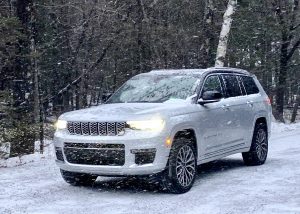

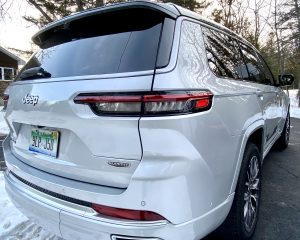
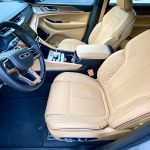
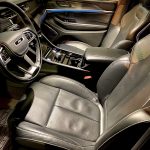
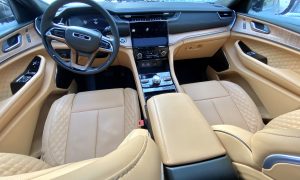
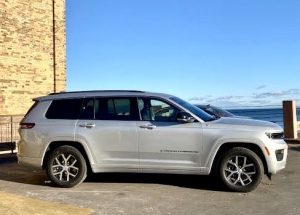
 John Gilbert is a lifetime Minnesotan and career journalist, specializing in cars and sports during and since spending 30 years at the Minneapolis Tribune, now the Star Tribune. More recently, he has continued translating the high-tech world of autos and sharing his passionate insights as a freelance writer/photographer/broadcaster. A member of the prestigious North American Car and Truck of the Year jury since 1993. John can be heard Monday-Friday from 9-11am on 610 KDAL(www.kdal610.com) on the "John Gilbert Show," and writes a column in the Duluth Reader.
John Gilbert is a lifetime Minnesotan and career journalist, specializing in cars and sports during and since spending 30 years at the Minneapolis Tribune, now the Star Tribune. More recently, he has continued translating the high-tech world of autos and sharing his passionate insights as a freelance writer/photographer/broadcaster. A member of the prestigious North American Car and Truck of the Year jury since 1993. John can be heard Monday-Friday from 9-11am on 610 KDAL(www.kdal610.com) on the "John Gilbert Show," and writes a column in the Duluth Reader.